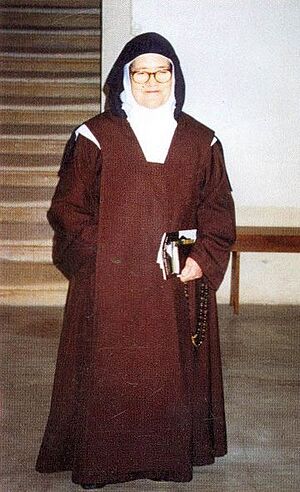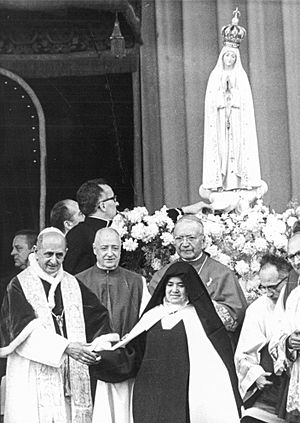Sister Lúcia facts for kids
Quick facts for kids VenerableSister Lúcia de Jesus Rosa dos Santos OCD |
|
|---|---|

Sister Lúcia at the Discalced Carmelite convent of Coimbra, circa 1998
|
|
| Born | 28 March 1907 Aljustrel, Fátima Kingdom of Portugal |
| Died | 13 February 2005 (aged 97) Coimbra, Portugal |
Lúcia de Jesus Rosa dos Santos (born March 28, 1907 – died February 13, 2005) was a Portuguese nun. She is also known as Lúcia of Fátima. She became a Carmelite nun and took the name Maria Lúcia of Jesus and of the Immaculate Heart.
When she was a child, Lúcia and her cousins, Francisco and Jacinta Marto, said they saw visions of the Virgin Mary. These visions happened in 1917 in Fátima, Portugal. Steps are being taken to recognize her as a saint.
Contents
Lúcia's Early Life
Lúcia was the youngest of seven children. Her parents were António dos Santos and Maria Rosa Ferreira. They lived in a village called Aljustrel, near Fátima. Even though they were farmers, her family owned land and was not poor.
Lúcia's official birthday was registered as March 22, 1907. However, she was actually born on March 28. Her parents registered her earlier to avoid a fine for late baptism.
Her father, António, was a hardworking and kind man. He taught Lúcia about the Catholic faith. Lúcia said he believed her and her cousins when they spoke about seeing Mary.
Lúcia's mother, Maria Rosa, could read. She loved religious stories and often told them. She also taught religious lessons to Lúcia and other children in the neighborhood. Lúcia was known for repeating everything she heard, like a "parrot."
Lúcia was a great storyteller herself. She made up songs with catchy tunes and wrote poems.
First Communion Experience
Lúcia received her First Communion when she was six years old. This was four years earlier than most children. At first, the local priest said she was too young. But a visiting priest, Father Cruz, spoke with Lúcia. He decided she understood the meaning of Communion better than many older children. After her First Confession, Lúcia prayed and said she saw a statue of Our Lady of the Rosary smile at her. This experience made a big impact on her. She said she no longer cared for worldly things and only felt happy in quiet places where she could remember her First Communion.
By the time she was eight, Lúcia was helping her family by looking after their sheep. She often did this with other children from the village.
The Fátima Apparitions
Between May and October 1917, Lúcia and her cousins, Francisco and Jacinta Marto, said they saw a bright lady. They believed this lady was the Virgin Mary. The visions happened in a field called Cova da Iria, near Fátima. The children said the lady appeared on the 13th day of each month around noon. This happened for six months.
One time, in August, the children were held by a local official. They did not see the lady again until they were released from jail two days later.
Messages from the Lady
Lúcia said the lady told the children to do good deeds and make sacrifices. This was to help save people who had done wrong. The lady also said it was important to say the rosary every day. This would bring peace to the world. Many young Portuguese men were fighting in World War I at that time.
Lúcia also heard Mary ask her to learn to read and write. Mary said that Jesus wanted Lúcia to share messages with the world. These messages were especially about Mary's Immaculate Heart.
Lúcia's mother found it hard to believe her daughter. She thought Lúcia was making things up to get attention. Lúcia faced difficulties from her mother, who was especially doubtful about the idea that Lúcia was asked to learn to read and write.
The Three Secrets of Fátima
On July 13, 1917, the lady reportedly shared three secrets with the children. Lúcia wrote down two of these secrets in 1941. She did this at the request of the Bishop of Leiria, José Alves Correia da Silva.
In 1943, Bishop da Silva asked Lúcia to write down the third secret. Lúcia found this difficult at first. She was unsure if God truly wanted her to share it. She was also a nun and had to obey her superiors. But in October 1943, she became very ill. She thought she might die, like her cousins had from the same illness. So, Bishop da Silva ordered her to write the secret.
Lúcia wrote the secret and sealed it in an envelope. She said it should not be opened until 1960. She believed that by then, the meaning would be clearer. The text of the third secret was officially shared by Pope John Paul II in the year 2000. The Vatican said the secret was a vision of the attempted assassination of Pope John Paul II in 1981.
The Miracle of the Sun
The stories of the visions became very well known. About 70,000 people were said to be present for the sixth and final vision. Lúcia had promised that the lady would perform a miracle that day. This was so that everyone would believe.
Witnesses at the Cova da Iria and even up to 25 miles away reported seeing the Sun change colors and spin like a wheel of fire. It cast multicolored light across the land. Some people said the Sun seemed to fall towards the Earth. This made many believe it was the end of the world. People often said the Sun "danced." This event became known as the Miracle of the Sun.
Newspapers in Portugal widely reported on the event. Even the New York Times mentioned it in a small article on October 17, 1917. Lúcia reported that on that day, the lady identified herself as "Our Lady of the Rosary." From then on, she also became known as Our Lady of Fátima.
The Catholic Church officially approved the visions as "worthy of belief" on October 13, 1930.
Life in the Convent
Lúcia moved to Porto in 1921. At 14, she joined a school run by the Sisters of St. Dorothy. In 1925, she entered the Institute of the Sisters of St. Dorothy in Pontevedra, Spain.
Lúcia said that on December 10, 1925, she saw a vision of the Virgin Mary and the Christ Child. The Virgin Mary asked for the practice of the Five First Saturdays devotion. She promised special help at the time of death to those who completed this devotion for five months in a row.
In 1926, Lúcia moved to Tuy and began her training to become a nun. She took her first vows in 1928. Sister Lúcia reported another vision on June 13, 1929. In this vision, the Blessed Virgin told her that God wanted the Pope, along with all the bishops, to consecrate Russia to her Immaculate Heart. Mary promised to save Russia through this act. Lúcia took her final vows in 1934 and was given the name "Sister Maria das Dores" (Mary of the Sorrows).
On January 25, 1938, a huge aurora borealis (a bright light in the sky) appeared over Europe. It was described as a "curtain of fire" or a "blood-red beam of light." Lúcia believed this was the "night illuminated by a strange light" that Mary had spoken about. Mary had said this light would be a sign before a major war, and she asked for acts of prayer and the Consecration of Russia.
In 1946, Lúcia returned to Portugal. In 1948, with special permission from the Pope, she joined the Carmelite convent of Santa Teresa in Coimbra. She lived there until she passed away. On May 31, 1949, she became a Discalced Carmelite and took the name Maria Lúcia of Jesus and the Immaculate Heart.
As a Carmelite nun, Lúcia was expected to speak very little with people from outside the convent. This rule led some people to think there was a secret plan to hide the Fátima message and keep Lúcia quiet.


Sister Lúcia returned to Fátima four times for papal visits. These visits were by Pope Paul VI in 1967 and Pope John Paul II in 1982, 1991, and 2000. In 2000, her cousins Jacinta and Francisco were recognized as blessed.
Sister Lúcia's Writings
Sister Lúcia wrote six memoirs during her life. The first four were written between 1935 and 1941. They are published in English as Fatima in Lucia's Own Words. The fifth and sixth memoirs were written later, in 1989 and 1993, and are published as Fatima in Lucia's Own Words II.
Another book, Calls from the Message of Fatima, was published in 2001. Sister Lúcia also wrote many letters to religious leaders and other people. These letters often answered questions about the Third Secret of Fátima and her understanding of Mary's requests. All of Sister Lúcia's writings are now kept for study by the Catholic Church.
Illness and Death
Before she died, Sister Lúcia had been blind and deaf for several years. She passed away at the Carmelite convent of Santa Teresa in Coimbra on February 13, 2005. She had lived there since 1948.
Steps to Sainthood
On February 13, 2008, Pope Benedict XVI announced that the process to make Sister Lúcia a saint would begin sooner than usual. On February 13, 2017, she was given the title "Servant of God." This is the first big step towards becoming a saint. In October 2022, a report on her life and good deeds was given to the Vatican. This report will help decide if she lived a life of "heroic virtue." On June 22, 2023, Pope Francis declared her "Venerable."
See also
 In Spanish: Lucía dos Santos para niños
In Spanish: Lucía dos Santos para niños
- First Saturdays Devotion
- Sanctuary of the Apparitions

